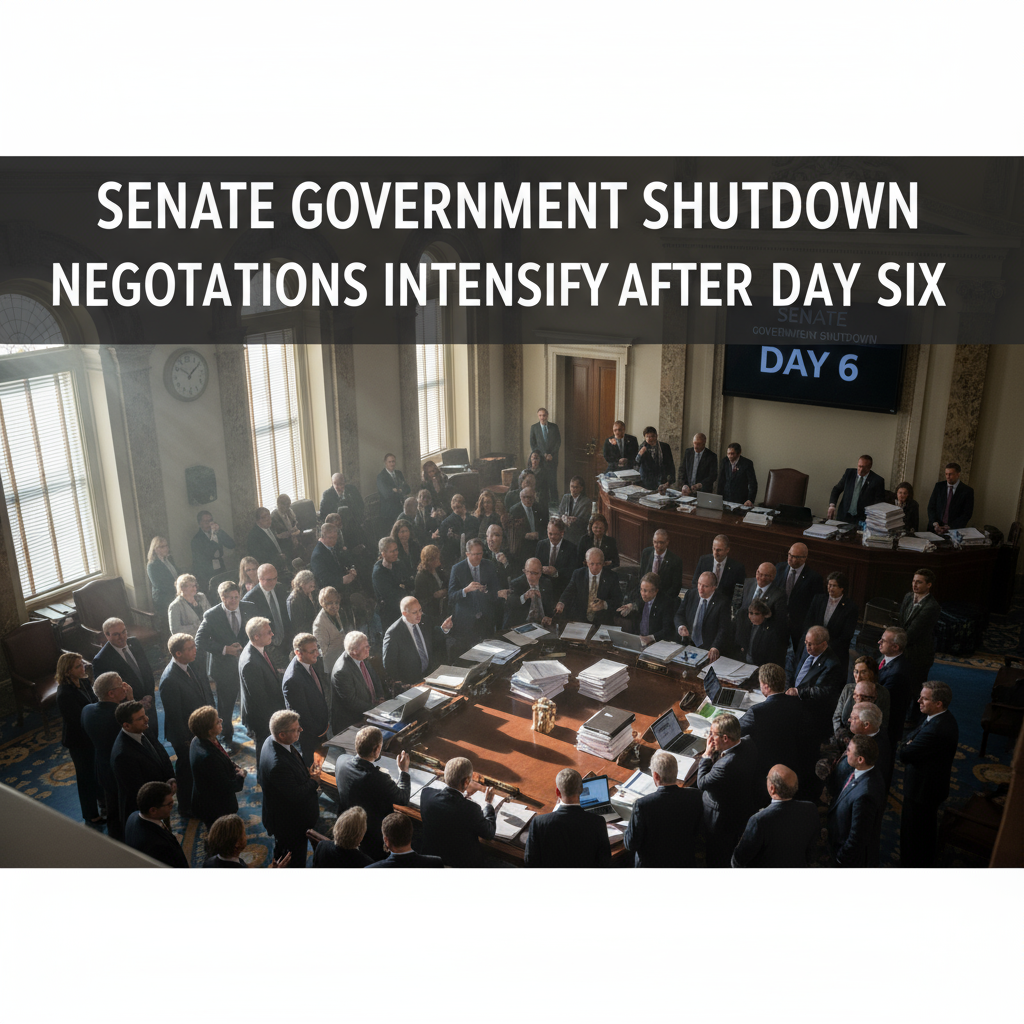Senate Government Shutdown Negotiations Intensify After Day Six
Estimated reading time: 5 minutes
- Stalemate in the Senate: No funding proposals have gained the necessary votes to advance.
- Human Impact: Over 620,000 federal employees have been furloughed, and essential services are at risk.
- Political Dynamics: Both parties are entrenched in their positions, complicating negotiations.
- Potential Layoffs: Federal workforce layoffs loom if the shutdown continues.
- Call for Cooperation: A plea for bipartisan dialogue and resolution amid growing tensions.
- Status of the Negotiations
- Escalating Pressure from Leadership
- The Blame Game and Communication Breakdown
- The Human Impact of the Shutdown
- Congressional Standoff
- Summary of Current Status
- Concluding Observations
Status of the Negotiations: A Stalemate
The critical moment reached on Monday is indicative of a significant impasse. Following multiple attempts, neither the Democratic nor the Republican funding proposals received the necessary 60 votes to advance in the Senate. Specifically, the Democrats’ bill was defeated by a vote of 45-55, while the Republicans’ alternative fell short at 52-42 [ABC News]. This marks a troubling continuation of dysfunction in government, where two opposing sides struggle to find common ground on essential fiscal matters.
Escalating Pressure from Leadership
As the situation grows dire, President Trump has publicly warned that continued failure to resolve the stalemate could lead to “reduction-in-force” (RIF) notices, a euphemism for layoffs affecting the federal workforce. He emphasized that if the shutdown persists, layoffs would likely target agencies whose priorities align closely with Democratic policies [ABC News]. The political implications of such threats exacerbate an already tense environment, as negotiators on both sides grapple with competing interests and perspectives.
The Blame Game and Communication Breakdown
As the deadline looms closer, the rhetoric from both parties has intensified. Senate Democrats, led by Chuck Schumer, have insisted that any budget deal must include measures to combat the anticipated rise in healthcare premiums for those enrolled under the Affordable Care Act (ACA) by renewing critical subsidies. In stark opposition, Republicans counter that these healthcare subsidies are not intrinsically linked to the budget discussions and should only be addressed once the government is reopened [ABC News].
Invalidating the claims of ongoing negotiations stated by President Trump, Schumer asserted that there were no current dialogues happening, yet expressed an openness to communicate if Republicans demonstrated commitment [ABC News]. This clash not only showcases the varied strategies each party employs but also points to the fractured landscape of political negotiations in Washington.
The Human Impact of the Shutdown
The ramifications of the government shutdown extend far beyond the Senate floor, deeply affecting the livelihoods of many citizens. Over 620,000 federal employees have been furloughed, a number that is likely to climb as the deadlock continues [Government Executive]. Essential services are growing increasingly impacted; federal food assistance programs for women, infants, and children are beginning to run low on required funding, raising the specter of starvation for vulnerable populations.
Moreover, the operational capacity of vital federal services is deteriorating. Air traffic control services, which underpin safety protocols nationwide, are facing severe staffing shortages. Burbank Airport has already implemented a full closure of its control tower, designated “ATC ZERO,” due to insufficient manpower. Other major airports, such as Newark, Denver, Detroit, Indianapolis, and Phoenix, are grappling with similar staffing deficits [ABC News], leading to potential safety hazards in air travel.
Congressional Standoff: No Progress in Sight
The dynamics in the House of Representatives also play a critical role in the shutdown saga. House Speaker Mike Johnson has underscored that any progress hinges on developments in the Senate, particularly since the House is not expected to convene again soon. Johnson maintains that the House has fulfilled its responsibilities by passing a stopgap measure, placing the onus of the ongoing crisis squarely on Senate Democrats [ABC News].
Summary of Current Status
The ongoing crisis can be summarized in a clear format, showcasing the current positions of both parties and the underlying issues that remain unresolved.
| Issue | Democratic Position | Republican/White House Position | Status |
|---|---|---|---|
| ACA Subsidies | Must be renewed in funding bill | Can be discussed after government reopens | No agreement |
| Reopening Government | Ready to negotiate if Republicans engage | Only negotiate certain issues after reopening | No direct talks |
| Proposed Layoffs (RIFs) | Oppose layoffs; blame Republicans/Trump | Threaten RIFs if shutdown continues | Layoff notices possible |
| Blame Assignment | Republicans causing harm; ready for compromise | Democrats intransigent, to blame for layoffs | Partisan standoff |
Concluding Observations
As the government shutdown stretches into its sixth day, the standoff in the Senate showcases not just political divergence, but the real human cost of such inertia. With critical services at risk and potential layoffs looming, both Democrats and Republicans must grapple with the implications of ongoing attrition between their conflicting ideologies.
The time for dialogue is now. Both sides must find a path forward that allows for bipartisan cooperation rather than continued cyclical blame. The public’s eyes remain fixed upon Washington, waiting for a resolution that could bring relief to the many affected by the current impasse.
Frequently Asked Questions (FAQ)
Q: What is the current status of the government shutdown?
A: The government shutdown has entered its sixth day with no agreement on funding proposals between the two parties.
Q: How are federal employees affected?
A: Over 620,000 federal employees have been furloughed, and significant layoffs are imminent if the stalemate continues.
Q: Are there any discussions between parties?
A: Currently, there are no open discussions, but there is a call for bipartisan engagement.
Q: What are the implications of the shutdown on essential services?
A: Services such as air traffic control and food assistance programs are at risk of being severely impacted.
For more trending news, visit NotAIWorld.com.
